Verdict
A phone with a specialised use in mind, the Cat S75 is tough enough to take some serious hits, and can be plunged into water safely. But when you take away its toughness and satellite messaging feature, it’s just another mid-ranger.
Pros
- Satellite messaging
- Good battery life
- Big and tough
Cons
- Big and heavy
- Screen is merely OK
- Limited satellite coverage right now
Introduction
You might already be familiar with the Cat brand if you’re in the habit of buying work boots, or possibly earth-moving equipment.
The Cat S75 isn’t quite on the same scale of toughness as a digger, but it’s a chunky phone which should be able to survive rough treatment, and can get a message out even if you’re in the middle of nowhere (in Europe, at least) thanks to its satellite connectivity and long battery life.
However, take away these features and it’s a fairly unimpressive mid-range phone that targets a specific niche, and won’t be attractive to anyone outside it.
Design and screen
- IP68 ingress protection
- Large, bulky design
- Coated with hardy Gorilla Glass
The Cat S75 is slightly thicker and heavier than most phones. There’s also a thick bezel around the screen, but apart from that there’s nothing that marks the S75 out from other Android smartphones.
There are no noticeable sealed doors over the USB port, as you’d find on a rugged laptop – it looks like a normal, if somewhat chunky, phone – but there are two extra buttons. The one on the left is large, ideal for pressing while wearing gloves, and is programmable.
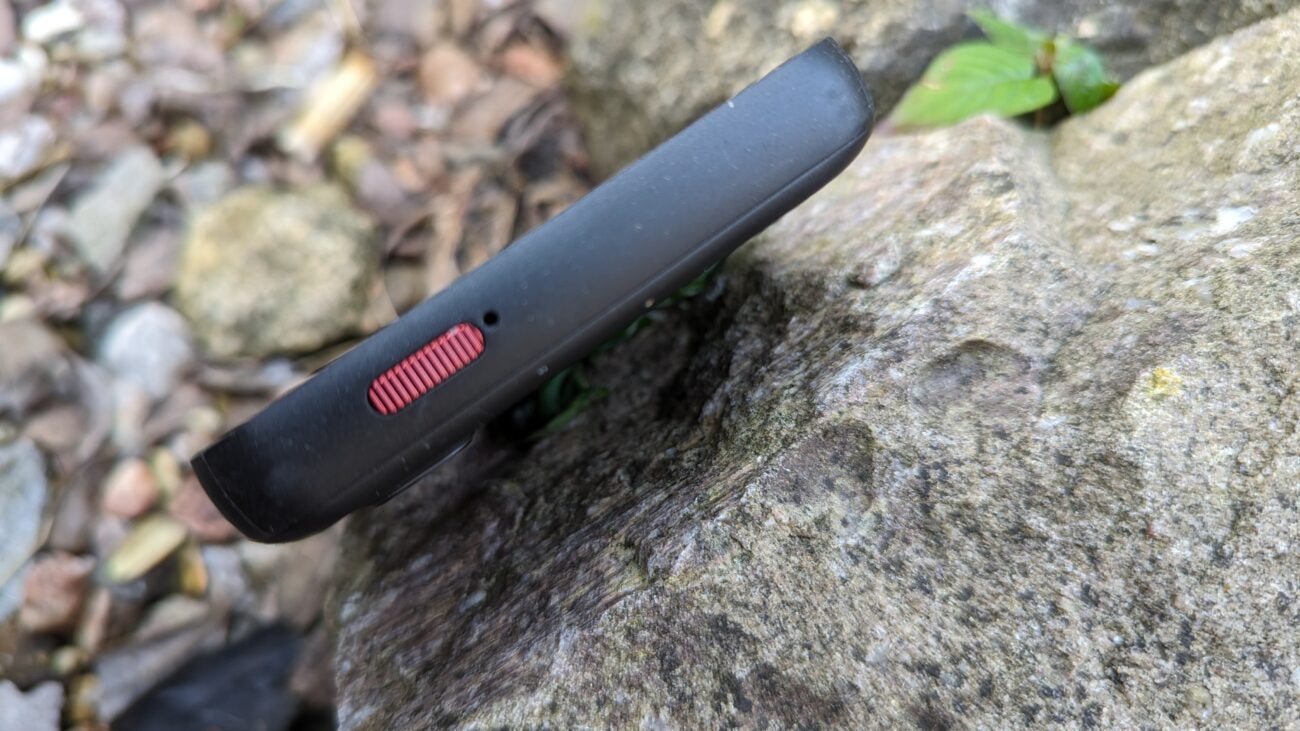
Cat S75 side buttons
Cat S75 SOS button
The one on the top, which is smaller and coloured red, is designated as an emergency alert button – hold it for five seconds and an SOS is sent via (by default) the satellite message service. The power button on the right-hand side of the handset is above the volume rocker, like on a Pixel phone, so may take a bit of getting used to if your current handset has them the other way around.
A phone like this isn’t meant to be flashy, it’s meant to be tough, and that means an armoured plastic back that wraps around the sides, as if it was already in a protective case. It’s big, but certainly not uncomfortable to hold – though there is a ridge around the screen that you’ll certainly feel with your ear. The integrated protection makes it less slippery than some glass phones, so it’s less likely to slide off the sofa, or the deck of a boat.
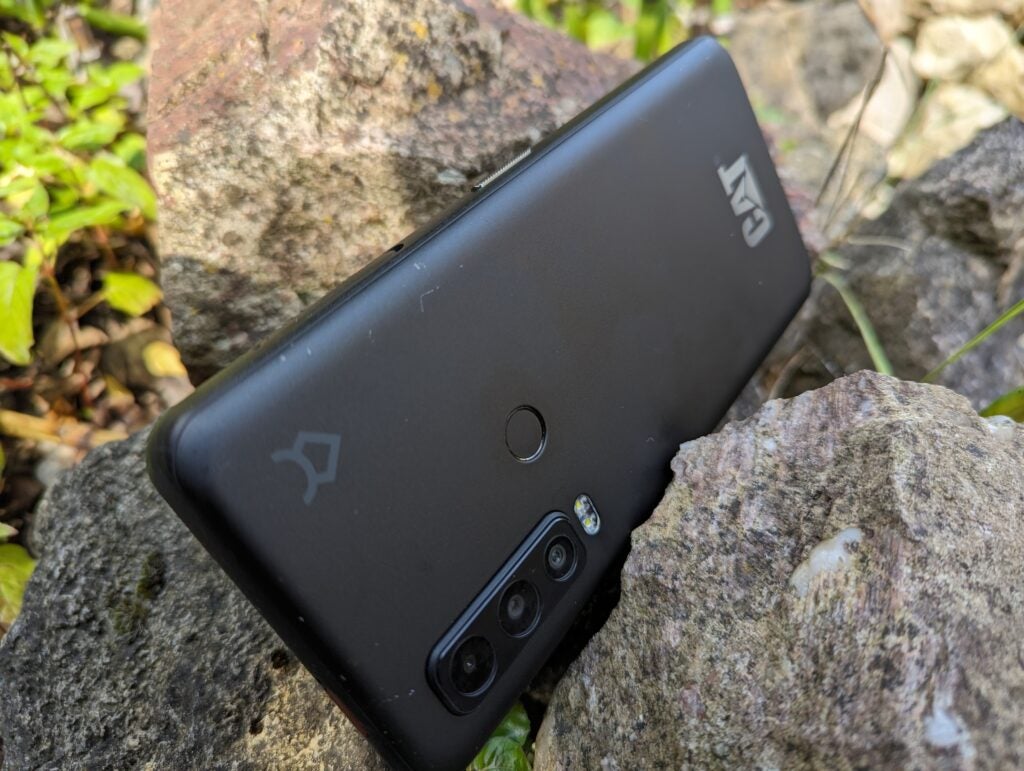
The screen is coated with Gorilla Glass, and the handset should withstand a 6ft drop onto a steel surface as well as submersion in water up to 5M deep for 35 minutes. This isn’t the selling point it once was – many phones now sport IP68 ingress protection, and putting your current phone in a protective case might be all the extra toughening it needs.
The screen, an IPS panel with an FHD+ resolution, does a pretty good job but pales in comparison to some of the AMOLED models out there. Again, this is a phone you’ll want to buy because of its satellite messaging and ability to shrug off rough treatment rather than something to stream Netflix on, but having a nice screen certainly helps.
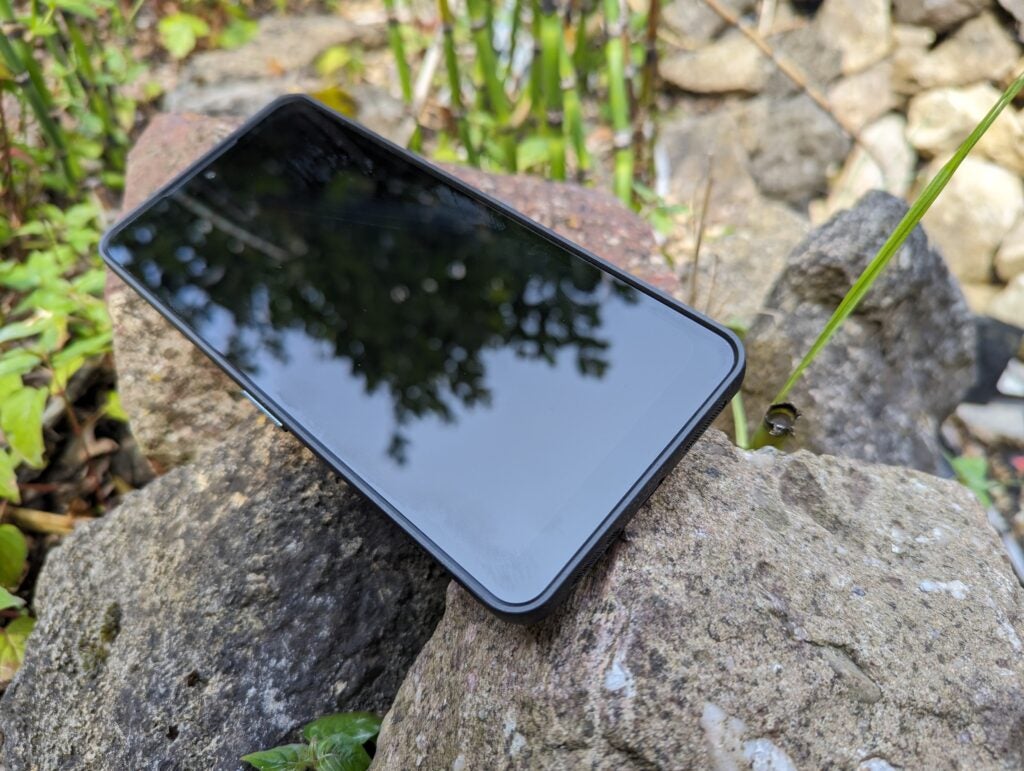
It has a slightly rough texture to it, distinct from the feel of a less rugged phone’s screen, which makes me wonder if there’s an integrated screen protector in place too. It’s rather reflective in direct sunlight, and not the brightest I’ve seen, but you can use it while wearing gloves or with wet hands.
Aside from the camera bulge, fingerprint reader (smaller than those on other phones, perhaps to help keep dust out), extra buttons and Cat logo there’s nothing that stands out visually about the phone. Perhaps its very genericness is another layer of protection.
Cameras
- Main sensor has 50MP sensor
- 8MP Ultrawide and 2MP Macro
- Poor photos in low-light conditions
On the back of the Cat S75 there’s a modest camera bulge, featuring three lenses and an LED flash (which, in a nice touch tailored to its intended use, is really bright so you can use it as a torch while escaping from caves).
The main camera is a 50MP unit, with a maximum aperture of f/1.8, which uses the Isocell JN1 sensor from Samsung. Announced in 2021 and used on phones by Redmi and Nothing, it puts out perfectly good 12.5MP files, though they can lack the colour pop and detail of images created with newer sensors.
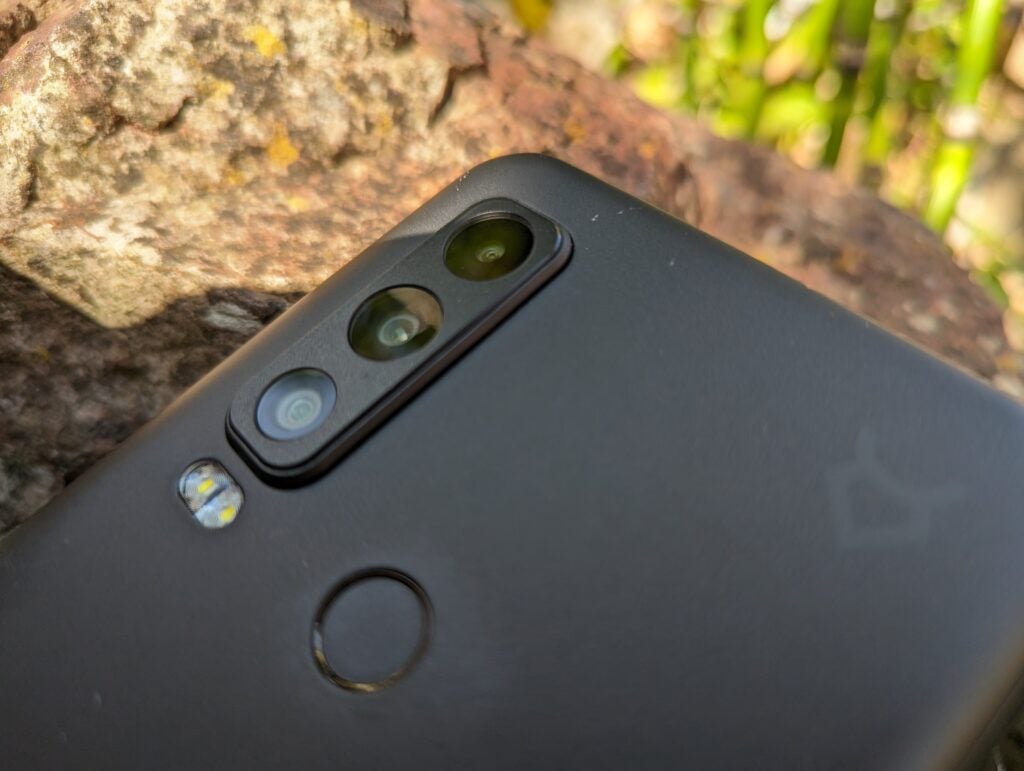
Switching between focal lengths isn’t achieved with a tap in the way most Android phones do, but using a slider. This means it’s easy to change to the 8MP ultrawide camera – and indeed it will do this automatically in some circumstances – rather than stick with the better quality files produced by the main camera.
It’s an awkward way of doing things, and will lead to some disappointing results, as the images from the ultrawide are noticeably worse than the main camera’s shots.
There’s a 2MP macro camera too, but the low-resolution files it produces aren’t much better than zooming in on a still from the main camera taken at its closest focusing distance, and it can be hard to focus with.
In low light the image quality falls apart, though it is helped by that bright flash. The usual Android night mode requires you and your subject to stay still, so doesn’t help greatly, and you’ll see increased noise and a lack of definition in shadow areas. Video options are slim, with a choice between 720p or 1080p recording, plus time lapse or slow motion.
Naturally, the camera can be used underwater. Triple-pressing the power button opens the camera app in underwater mode, from where you can use the volume buttons to trigger the shutter. I tried it in a lit aquarium, but the lack of strong light increased the shutter speeds so much that getting a sharp image of fast-moving fish was impossible, though you may do better if photographing rocks.
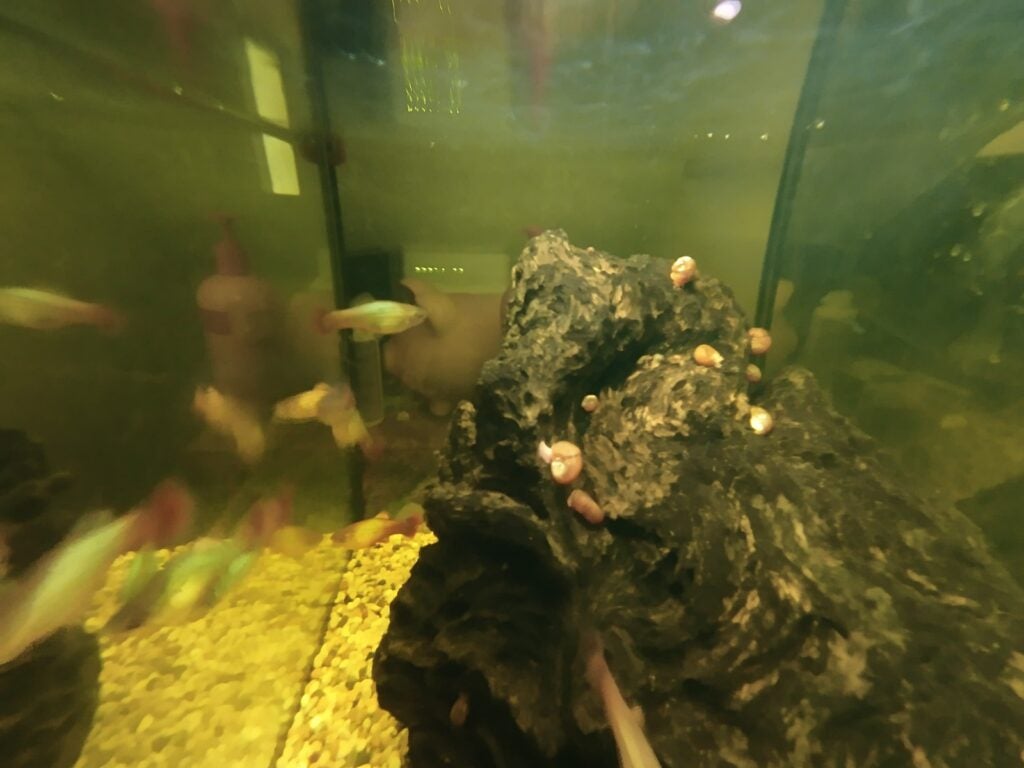
The 8MP front camera is set into the top of the screen and, even with HDR mode switched on, produces washed-out colours and smeared detail. It’s fine for making video calls, but I wouldn’t rely on it for a good quality shot.
Performance
- Slower than other mid-range phones
- Not the the best option for gaming
- Satellite messaging only viable in Europe
The eight-core chipset at the heart of the Cat S75 is split into clusters of two A78 cores and six A55s, an unusual arrangement from an industry that likes to keep things in groups of four.
It has a non-standard GPU as well – Dimensity 900 phones such as the Oppo Reno 7 or OnePlus Nord CE2 5G usually push pixels with a Mali G68 chip, but the Cat has one from PowerVR instead. This means that the phone lacks the pure processing power that others with more A78 cores – such as the Samsung Galaxy S21 – have, but it’s certainly not a poor performer.
It might not be one of the best phones for gaming, but there’s enough there to run the OS, and performance in things like mapping and messaging apps are probably more important for the target audience of a phone like this.
The feature that’s going to attract a lot of adventurous people to the phone is the satellite messaging service, which allows you to make contact with civilisation even when out of range of phone service, as long as you can get an unobstructed view of the sky.
On the S75 it’s provided by Bullitt, and offers two-way communication for text messages, but requires you to use a special SIM card that goes in the phone’s second slot. This means you’re unable to use the satellite SIM and the phone’s MicroSD expansion or dual-(normal)-SIM ability at the same time, though with 128GB of storage on board you might never need to bring a MicroSD card anywhere near it.
Once you’ve set up an account with Bullitt, subscribed to a plan and logged into its app, you can start sending messages, though you may need to align the phone to the sky first, depending on coverage. I tried it indoors and couldn’t get a fix – you need a GPS signal and a clear view of the southern sky (I was at 51° north), but still may not get a signal – it regularly said ‘connection unavailable’ even with the satellite in the right position.
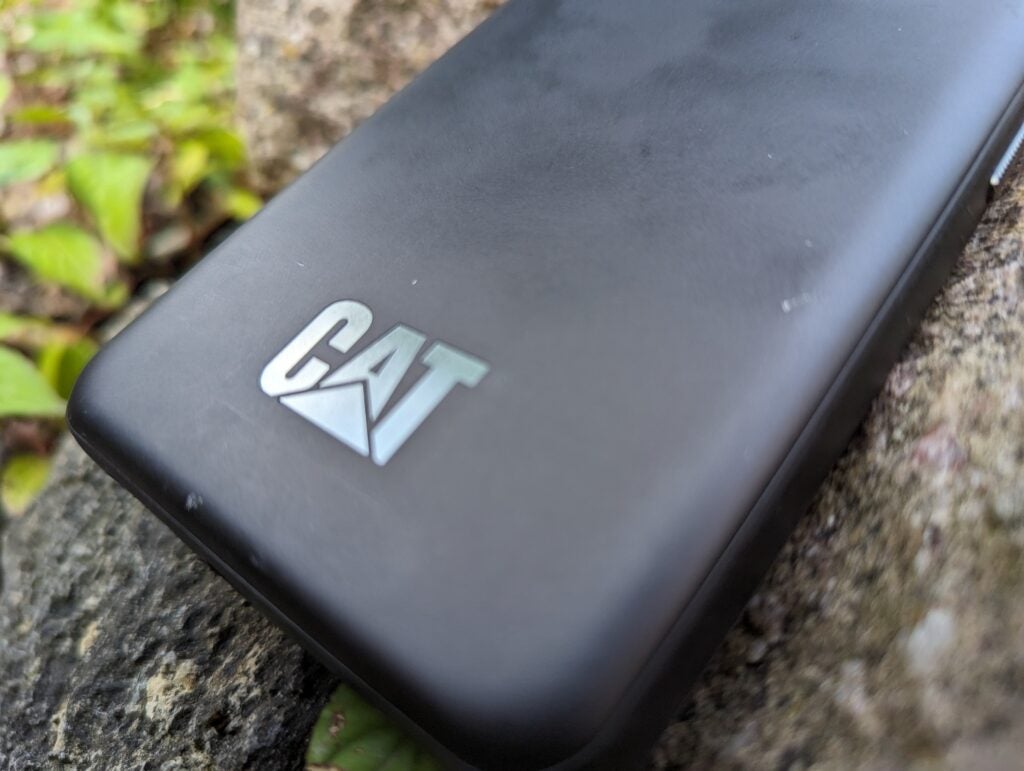
I then tried it in a notorious phone dead spot outside a house in Somerset, and found that a clear view of the sky (with no buildings or other obstructions) was essential. I managed to get some messages through, including my GPS coordinates, but the app spent more time telling me the service was unavailable than it did actually working.
The message then comes through on the recipient’s phone as a normal SMS if they don’t have the Bullitt app installed. Message plans vary from 30 a month for €4.99 (£4.30, $5.50), to 250 in a whole year for €59 (£50.50, $64.50). All plans come with emergency SOS service, and there’s a three-month free trial of the cheapest plan with the Cat phone. You can also use it to send SOS messages that alert the emergency services.
The only slight issue is in the satellite coverage. A check of the Bullitt website reveals that if you’re in Europe you’ll be able to use the service right now. The continental USA should be online in June 2023 followed by Canada and southern Alaska in July. The whole of Africa, Central and South America, Japan and Australasia (except Tasmania) are marked as ‘Q3 2023’, and if you want to go hiking in Russia, India, or China you’re out of luck, as they’re marked ‘unsupported’.
Some countries, such as most of the Middle East, Mongolia, South Korea and Myanmar are ‘unverified’. Some of this is due to wars, inconvenient political regimes, or government regulation of satellite communications. Things may change, but at the time of writing this is very much a Europe-only system.
Battery life
- Packs a 5000mAh cell
- Capable of 17 hours on single charge
Given the size of the phone, and the battery size of 5,000mAh – at the top end of the power cells usually used in phones – I had high expectations for the Cat S75’s battery life, and I wasn’t disappointed.
It managed 17 hours of constant use in my tests before entering its battery saver mode, which points to a life measured in whole days if left on standby. If you know you’re going to be out of range, you can switch the phone to a satellite-only mode, which should stop the 5G and Wi-Fi from banging away and wasting power.
Cat hasn’t revealed in its marketing materials how much power the phone can draw from the wall, but I hooked it up to a 60W charger and saw it fully juiced-up in about two and a half hours.
Latest deals
Should you buy it?
If you’ll make use of the satellite messaging feature, or need a tough phone.
If you want a mid-range phone for everyday use, there are cheaper and better options.
Final Thoughts
The Cat S75 targets a specialised niche. Not everyone is going to require a phone that’s sealed and hardened to this degree, and its performance isn’t as good as cheaper phones from other manufacturers.
The phone seems aimed at those who intend to get really lost and away from the beaten track in the wilds of Europe. Once the satellite service is widened to include more of the world, then it may become more useful for travellers, scientists, journalists or anyone else popping into the jungle away from phone coverage.
Without the satellite messaging system it’s a mid-range phone that’s let down by having 6GB of RAM instead of 8, and by a GPU that seems a step down from the usual one found in Dimensity 900 phones. The tough exterior and waterproofing is nice to have, but they’re not enough to buy this phone over others if you’re looking for something to use all the time. Check out our Best Phones list for more options.
How we test
We test every mobile phone we review thoroughly. We use industry-standard tests to compare features properly and we use the phone as our main device over the review period. We’ll always tell you what we find and we never, ever, accept money to review a product.
Find out more about how we test in our ethics policy.
FAQs
Yes, the Cat S75 is a 5G smartphone.
The Cat S75 can be dropped onto concrete from up to 1.8m high without breaking, and can be dunked in 5m deep water for up to 35 minutes.
Trusted Reviews test data
Verdict
A phone with a specialised use in mind, the Cat S75 is tough enough to take some serious hits, and can be plunged into water safely. But when you take away its toughness and satellite messaging feature, it’s just another mid-ranger.
Pros
- Satellite messaging
- Good battery life
- Big and tough
Cons
- Big and heavy
- Screen is merely OK
- Limited satellite coverage right now
Introduction
You might already be familiar with the Cat brand if you’re in the habit of buying work boots, or possibly earth-moving equipment.
The Cat S75 isn’t quite on the same scale of toughness as a digger, but it’s a chunky phone which should be able to survive rough treatment, and can get a message out even if you’re in the middle of nowhere (in Europe, at least) thanks to its satellite connectivity and long battery life.
However, take away these features and it’s a fairly unimpressive mid-range phone that targets a specific niche, and won’t be attractive to anyone outside it.
Design and screen
- IP68 ingress protection
- Large, bulky design
- Coated with hardy Gorilla Glass
The Cat S75 is slightly thicker and heavier than most phones. There’s also a thick bezel around the screen, but apart from that there’s nothing that marks the S75 out from other Android smartphones.
There are no noticeable sealed doors over the USB port, as you’d find on a rugged laptop – it looks like a normal, if somewhat chunky, phone – but there are two extra buttons. The one on the left is large, ideal for pressing while wearing gloves, and is programmable.

Cat S75 side buttons
Cat S75 SOS button
The one on the top, which is smaller and coloured red, is designated as an emergency alert button – hold it for five seconds and an SOS is sent via (by default) the satellite message service. The power button on the right-hand side of the handset is above the volume rocker, like on a Pixel phone, so may take a bit of getting used to if your current handset has them the other way around.
A phone like this isn’t meant to be flashy, it’s meant to be tough, and that means an armoured plastic back that wraps around the sides, as if it was already in a protective case. It’s big, but certainly not uncomfortable to hold – though there is a ridge around the screen that you’ll certainly feel with your ear. The integrated protection makes it less slippery than some glass phones, so it’s less likely to slide off the sofa, or the deck of a boat.

The screen is coated with Gorilla Glass, and the handset should withstand a 6ft drop onto a steel surface as well as submersion in water up to 5M deep for 35 minutes. This isn’t the selling point it once was – many phones now sport IP68 ingress protection, and putting your current phone in a protective case might be all the extra toughening it needs.
The screen, an IPS panel with an FHD+ resolution, does a pretty good job but pales in comparison to some of the AMOLED models out there. Again, this is a phone you’ll want to buy because of its satellite messaging and ability to shrug off rough treatment rather than something to stream Netflix on, but having a nice screen certainly helps.

It has a slightly rough texture to it, distinct from the feel of a less rugged phone’s screen, which makes me wonder if there’s an integrated screen protector in place too. It’s rather reflective in direct sunlight, and not the brightest I’ve seen, but you can use it while wearing gloves or with wet hands.
Aside from the camera bulge, fingerprint reader (smaller than those on other phones, perhaps to help keep dust out), extra buttons and Cat logo there’s nothing that stands out visually about the phone. Perhaps its very genericness is another layer of protection.
Cameras
- Main sensor has 50MP sensor
- 8MP Ultrawide and 2MP Macro
- Poor photos in low-light conditions
On the back of the Cat S75 there’s a modest camera bulge, featuring three lenses and an LED flash (which, in a nice touch tailored to its intended use, is really bright so you can use it as a torch while escaping from caves).
The main camera is a 50MP unit, with a maximum aperture of f/1.8, which uses the Isocell JN1 sensor from Samsung. Announced in 2021 and used on phones by Redmi and Nothing, it puts out perfectly good 12.5MP files, though they can lack the colour pop and detail of images created with newer sensors.

Switching between focal lengths isn’t achieved with a tap in the way most Android phones do, but using a slider. This means it’s easy to change to the 8MP ultrawide camera – and indeed it will do this automatically in some circumstances – rather than stick with the better quality files produced by the main camera.
It’s an awkward way of doing things, and will lead to some disappointing results, as the images from the ultrawide are noticeably worse than the main camera’s shots.
There’s a 2MP macro camera too, but the low-resolution files it produces aren’t much better than zooming in on a still from the main camera taken at its closest focusing distance, and it can be hard to focus with.
In low light the image quality falls apart, though it is helped by that bright flash. The usual Android night mode requires you and your subject to stay still, so doesn’t help greatly, and you’ll see increased noise and a lack of definition in shadow areas. Video options are slim, with a choice between 720p or 1080p recording, plus time lapse or slow motion.
Naturally, the camera can be used underwater. Triple-pressing the power button opens the camera app in underwater mode, from where you can use the volume buttons to trigger the shutter. I tried it in a lit aquarium, but the lack of strong light increased the shutter speeds so much that getting a sharp image of fast-moving fish was impossible, though you may do better if photographing rocks.

The 8MP front camera is set into the top of the screen and, even with HDR mode switched on, produces washed-out colours and smeared detail. It’s fine for making video calls, but I wouldn’t rely on it for a good quality shot.
Performance
- Slower than other mid-range phones
- Not the the best option for gaming
- Satellite messaging only viable in Europe
The eight-core chipset at the heart of the Cat S75 is split into clusters of two A78 cores and six A55s, an unusual arrangement from an industry that likes to keep things in groups of four.
It has a non-standard GPU as well – Dimensity 900 phones such as the Oppo Reno 7 or OnePlus Nord CE2 5G usually push pixels with a Mali G68 chip, but the Cat has one from PowerVR instead. This means that the phone lacks the pure processing power that others with more A78 cores – such as the Samsung Galaxy S21 – have, but it’s certainly not a poor performer.
It might not be one of the best phones for gaming, but there’s enough there to run the OS, and performance in things like mapping and messaging apps are probably more important for the target audience of a phone like this.
The feature that’s going to attract a lot of adventurous people to the phone is the satellite messaging service, which allows you to make contact with civilisation even when out of range of phone service, as long as you can get an unobstructed view of the sky.
On the S75 it’s provided by Bullitt, and offers two-way communication for text messages, but requires you to use a special SIM card that goes in the phone’s second slot. This means you’re unable to use the satellite SIM and the phone’s MicroSD expansion or dual-(normal)-SIM ability at the same time, though with 128GB of storage on board you might never need to bring a MicroSD card anywhere near it.
Once you’ve set up an account with Bullitt, subscribed to a plan and logged into its app, you can start sending messages, though you may need to align the phone to the sky first, depending on coverage. I tried it indoors and couldn’t get a fix – you need a GPS signal and a clear view of the southern sky (I was at 51° north), but still may not get a signal – it regularly said ‘connection unavailable’ even with the satellite in the right position.

I then tried it in a notorious phone dead spot outside a house in Somerset, and found that a clear view of the sky (with no buildings or other obstructions) was essential. I managed to get some messages through, including my GPS coordinates, but the app spent more time telling me the service was unavailable than it did actually working.
The message then comes through on the recipient’s phone as a normal SMS if they don’t have the Bullitt app installed. Message plans vary from 30 a month for €4.99 (£4.30, $5.50), to 250 in a whole year for €59 (£50.50, $64.50). All plans come with emergency SOS service, and there’s a three-month free trial of the cheapest plan with the Cat phone. You can also use it to send SOS messages that alert the emergency services.
The only slight issue is in the satellite coverage. A check of the Bullitt website reveals that if you’re in Europe you’ll be able to use the service right now. The continental USA should be online in June 2023 followed by Canada and southern Alaska in July. The whole of Africa, Central and South America, Japan and Australasia (except Tasmania) are marked as ‘Q3 2023’, and if you want to go hiking in Russia, India, or China you’re out of luck, as they’re marked ‘unsupported’.
Some countries, such as most of the Middle East, Mongolia, South Korea and Myanmar are ‘unverified’. Some of this is due to wars, inconvenient political regimes, or government regulation of satellite communications. Things may change, but at the time of writing this is very much a Europe-only system.
Battery life
- Packs a 5000mAh cell
- Capable of 17 hours on single charge
Given the size of the phone, and the battery size of 5,000mAh – at the top end of the power cells usually used in phones – I had high expectations for the Cat S75’s battery life, and I wasn’t disappointed.
It managed 17 hours of constant use in my tests before entering its battery saver mode, which points to a life measured in whole days if left on standby. If you know you’re going to be out of range, you can switch the phone to a satellite-only mode, which should stop the 5G and Wi-Fi from banging away and wasting power.
Cat hasn’t revealed in its marketing materials how much power the phone can draw from the wall, but I hooked it up to a 60W charger and saw it fully juiced-up in about two and a half hours.
Latest deals
Should you buy it?
If you’ll make use of the satellite messaging feature, or need a tough phone.
If you want a mid-range phone for everyday use, there are cheaper and better options.
Final Thoughts
The Cat S75 targets a specialised niche. Not everyone is going to require a phone that’s sealed and hardened to this degree, and its performance isn’t as good as cheaper phones from other manufacturers.
The phone seems aimed at those who intend to get really lost and away from the beaten track in the wilds of Europe. Once the satellite service is widened to include more of the world, then it may become more useful for travellers, scientists, journalists or anyone else popping into the jungle away from phone coverage.
Without the satellite messaging system it’s a mid-range phone that’s let down by having 6GB of RAM instead of 8, and by a GPU that seems a step down from the usual one found in Dimensity 900 phones. The tough exterior and waterproofing is nice to have, but they’re not enough to buy this phone over others if you’re looking for something to use all the time. Check out our Best Phones list for more options.
How we test
We test every mobile phone we review thoroughly. We use industry-standard tests to compare features properly and we use the phone as our main device over the review period. We’ll always tell you what we find and we never, ever, accept money to review a product.
Find out more about how we test in our ethics policy.
FAQs
Yes, the Cat S75 is a 5G smartphone.
The Cat S75 can be dropped onto concrete from up to 1.8m high without breaking, and can be dunked in 5m deep water for up to 35 minutes.

























